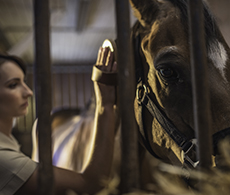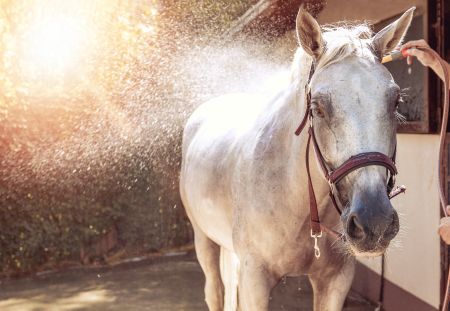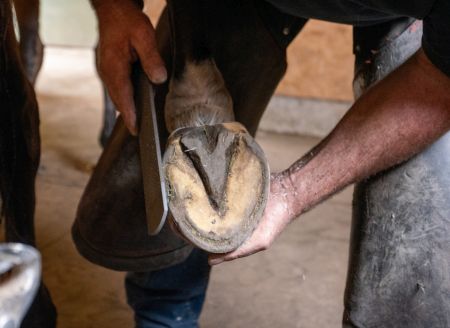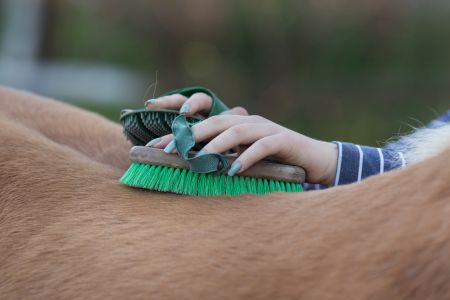
Grooming tips for winter
Winter can negatively impact a horse’s coat and hooves and leave them weak and in poor condition. Our expert advice will help you keep your horse in tip-top shape this season.
Looking after their skin

‘Excess water and mud are a nightmare for horses’ skin,’ says vet Gil Riley. ‘Mud can cause infections on the horse’s back in the form of rain scald, and mud fever on the legs.’
To help prevent these, ‘Ensure mud is brushed off as the horse comes in or hose the legs and dry them thoroughly with a towel,’ he explains. ‘Pick out the feet and wash them inside and out, and ensure your horse is fully dry before putting them in a stable with clean, dry, water-absorbent bedding.’
But, if this fails, treatment is the same for both conditions: ‘Carefully clip away hair around the infected areas, clean gently with Hibiscrub and warm water, and add a soothing antibiotic ointment. You can also add an antibiotic powder to the feed,’ Gil shares.
Assessing your paddock, preferably before winter sets in, could also help prevent disease. ‘Gateways can become very water-logged and, when a horse stands in mud for hours, it can exacerbate infections in hooves,’ says Gil. ‘Look at improving drainage and consider putting gravel down, and try preventing your horse from standing in the gateway for periods of time.’
Aside from these conditions, excess dandruff, itching, skin sores and a dull-looking coat can signal poor health and should be investigated by your vet. And look out for parasites. ‘Lice are common in horses with lowered immune systems or Cushings disease,’ Gil states. ‘They’ll be particularly itchy, and you may see a few bald patches from scratching. Shop-bought lice treatments are effective in treating these.’
Feather mites are also more common in winter. ‘These cause horses to rub their hind legs and stamp, due to irritation,’ says Gil. ‘Keep the legs clipped and apply a mite treatment, which is available from your vets.’
You could also get your horse tested for encysted red worm larva around the beginning of November. “A new blood test identifies the larvae of the encysted small redworm,” Gil reveals.
Help them put their best foot forward

‘After a long, hard summer season, horses’ feet can be fatigued,’ reveals farrier Greig Elliott. ‘Winter is a great opportunity to remove their shoes to allow old nail holes time to grow out and feet to recover.’ After the initial trim, Greig recommends a second after two weeks to limit breakages of the hoof wall and preserve strength, then a final trim three or four weeks later.
For horses that come in and out during the day, rainy weather can exacerbate problems. ‘Bacteria thrives in wet, muddy conditions and, when horses come into a warmer stable environment, the bacteria multiplies,’ Greig explains. ‘Thrush is probably the most prevalent winter issue. The frog is perfect for trapping bacteria, so clean the clefts, centrally and either side, daily.’
To identify thrush-affected tissue, check for dark, soft areas and an unpleasant smell. To treat it, use ‘a broad-spectrum anti-bacterial and anti-fungal treatment – but don’t apply this while feet are wet,’ says Greig. ‘Put the horse in the stable to dry, and then treat them. Another tip is to alternate two different treatments between morning and evening. But remember that thrush can be aggressive. If it starts to affect the sensitive structures, call the vet.’
Greig warns that hoof soles can also be affected by the wet weather. ‘Water can get under the pads and cause soles to become “washed out”, which lowers the natural depth and protection the sole offers; increasing the likelihood of bruised feet or abscesses.’ In these instances, avoid stony terrain and apply sole hardeners – and speak to your farrier about nailing equithane or leather pads under the shoe for added protection.
When caring for horse hooves that are brittle, flaky and prone to abscesses, he suggests considering a supplement. ‘Look for supplements rich in biotin, zinc, amino acids and copper, as they can help improve the quality of horn, and prevent winter related diseases.’
Adapting your management

Just as we take a different approach to self-care in cold weather, the winter also calls for changes in the management of your horse.
‘At this time of year, I curry comb horses twice daily – they’re changing coats and shedding, and it’s a great way to get the hair out,’ says Alan Davies, world-class groom for Carl Hester and Charlotte Dujardin. ‘After brushing, I add a few drops of baby oil to hot water and hot cloth them all over to keep skin clean and soft.’
However, when rugging, Alan believes in a less is more approach. ‘By using multiple thin layers, you can better control the temperature – I use a cotton sheet first, then add thinner rugs as required. Properly fitting rugs prevent rubbing and, for the extra sensitive, silk shoulder liners also help.’
After exercise, wash horses thoroughly to remove sweat, and ensure they’re completely dry before re-rugging. ‘If they get a skin reaction from sweat, keep them cool and call your vet, who can give antibiotics,’ Alan states. Keeping apparel clean is also important. ‘We wash numnahs after each wear and rinse the girths off, so they’re fresh for every use,’ he adds.
When horses come in, Alan ensures their feet are thoroughly cleaned to remove stones and mud. Plus, ‘We use Nettex hoofcare products daily (hoof oil moisturisers and protectors), to protect both the inside and outside of the foot,’ he says. A regular check by a farrier also helps to prevent cracks and breaks.
Last but not least, don’t forget nutrition. ‘We feed horses more forage during winter to help them stay warm, and add an oil supplement to their feed, such as soya oil. This keeps their coats nice and healthy from the inside,’ explains Alan. ‘We also feed a hoof supplement if needed, but proper management ensures they obtain necessary nutrients from their diet.’


